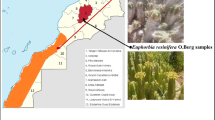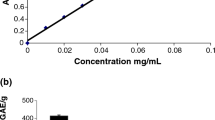Abstract
In this study, the antioxidant activity and the protective effect against hydrogen peroxide-induced DNA damage were assessed for five honeys of different botanical origin. Seven phenolic acids were detected in the honey samples. Ferulic acid was the most abundant phenolic acid detected in longan honey, jujube honey and buckwheat honey. Ellagic acid, p-hydroxybenzoic acid and protocatechuic acid were the main phenolic acids detected in vitex honey. Of all honey samples tested, the highest total phenolic content and antioxidant activity were found in buckwheat honey, whereas the lowest total phenolic content and antioxidant activity were found in locust honey. Treatment with hydrogen peroxide induced a 62% increase in tail DNA in mice lymphocytes, and all studied honeys significantly inhibited this effect (P < 0.05). The buckwheat honey with higher antioxidant capability also exhibited super protective effect than others. Phenolic extracts of honey displayed greater protective effects than whole honey in comet assay. The hydrogen peroxide-generated increase in 8-hydroxy-2-deoxyguanosine (8-OHdG) was effectively inhibited by the honeys studied (P < 0.05). Moreover, a dose-effect relationship between honey concentration and its protective effect was clearly observed in this study. It can be deduced that phenolic acids of honey can penetrate into lymphocytes and protect DNA from oxidative damage by scavenging hydrogen peroxide and/or chelating ferrous ions.





Similar content being viewed by others
References
Cross CE, Halliwell B, Borish ET, Pryor WA, Ames BN, Saul RL, McCord JM, Harman D (1987) Oxygen radicals and human disease. Ann Intern Med 107:526–545
Yang JY, Li Y, Wang F, Wu C (2010) Hepatoprotective effects of apple polyphenols on CCl4-induced acute liver damage in mice. J Agric Food Chem 58:6525–6531
Ranilla LG, Kwon Y, Apostolidis E, Shetty K (2010) Phenolic compounds, antioxidant activity and in vitro inhibitory potential against key enzymes relavant for hyperglycemia and hypertension of commonly used medicinal plants, herbs and spices in Latin America. Bioresour Technol 101:4676–4689
Arulselvan P, Subramanian SP (2007) Beneficial effects of Murraya koenigii leaves on antioxidant defense system and ultra structural changes of pancreatic β–cells in experiment diabetes in rats. Chem-Bio Interact 165:155–164
McKelvey-Martin VJ, Green MHL, Pool-Zobel BL, Méo MPD, Collins A (1993) The single cell gel electrophoresis assay (comet assay): a European review. Mutat Res-Fund Mol M 288(1):47–63
Klaude M, Eriksson S, Nygren J, Ahnström G (1996) The comet assay: mechanisms and technical considerations. Mutat Res-DNA Repair 363:89–96
Festa F, Aglitti T, Duranti G, Ricordy R, Perticone P, Cozzi R (2001) Strong antioxidant activity of ellagic acid in mammalian cells in vitro revealed by the comet assay. Anticancer Res 21(6A):3903–3908
Cheng N, Wang Y, Gao H, Yuan J, Feng F, Cao W, Zheng J (2013) Protective effect of extract of Crataegus pinnatifida pollen DNA damage response to oxidative stress. Food Chem Toxicol 59:709–714
Kassim M, Achoui M, Mustafa MR, Mohd MA, Yusoff KM (2010) Ellagic acid, phenolic acids, and flavonoids in Malaysian honey extracts demonstrate in vitro anti-inflammatory activity. Nutr Res 30:650–659
Fukuda M, Kobayashi K, Hirono Y, Miyagawa M, Ishida T, Ejiogu EC, Sawai M, Pinkerton KE (2011) Jungle honey enhances immune function and antitumor activity. Evid-based Compl Alt Article ID 908743:8. https://doi.org/10.1093/ecam/nen086
Flanjak I, Kenjerić D, Bubalo D, Primorac L (2016) Characterisation of selected Croatian honey types based on the combination of antioxidant capacity quality parameters, and chemometrics. Eur Food Res Technol 242(4):467–475
Zhou J, Li P, Cheng N, Gao H, Wang BN, Wei YH, Cao W (2012) Protective effects of buckwheat honey on DNA damage induced by hydroxyl radicals. Food Chem Toxicol 50:2766–2773
Ahmad I, Jimenez H, Yaacob NS, Yusuf N (2012) Tualang honey protects keratinocytes from ultraviolet radiation-induced inflammation and DNA damage. Photochem Photobiol 88(5):1198–1204
Yao LK, Razak SLA, Ismail N, Fai NC, Asgar MHAM, Sharif NM, Aan GJ, Jubri Z (2011) Malaysian gelam honey reduces oxidative damage and modulates antioxidant enzyme activities in young and middle aged rats. J Med Plants Res 5(23):5618–5625
Martos I, Ferreres F, FA T–B (2000) Identification of flavonoid markers for the botanical origin of eucalyptus honey. J Agric Food Chem 48:1498–1502
Wang J, Xue X, Du X, Cheng N, Chen L, Zheng J, Cao W (2014) Identification of acacia honey adulteration with rape honey using liquid chromatography-electrochemical detection and chemometrics. Food Anal Methods 7:2003–2012
Singelton VR, Orthifer R, Orthifer R, Lamudla-Raventos RM (1999) Analysis of total phenols and other oxidation substrates and antioxidants by means of folin-ciocalteu reagent. Methods Enzymol 299:152–178
Brand-Williams W, Cuvelier ME, Berset C (1995) Use of a free radical method to evaluate antioxidant activity. Lebensm-Wiss Technol 28:25–30
Nandita S, Rajini PS (2004) Free radical scavenging activity of an aqueous extract of potato peel. Food Chem 85:611–616
Benzie IFF, Strain JJ (1996) The ferric reducing ability of plasma as a measure of “antioxidant power”: the FRAP assay. Anal Biochem 239:70–76
Singh NP, McCoy MT, Tice RR, Schneider EL (1988) A simple technique for quantitation of low levels of DNA damage in individual cells. Exp Cell Res 175:184–191
Sedmak JJ, Grossberg SE (1977) A rapid, sensitive, and versatile assay for protein using Coomassie brilliant blue G250. Anal Biochem 79:544–552
Block G (1992) The data support a role for antioxidants in reducing cancer risk. Nutr Rev 50:207–213
Leja M, Kamińska I, Kramer M, Maksylewicz-Kaul A, Kammerer D, Carle R, Baranski R (2013) The content of phenolic compounds and radical scavenging activity varies with carrot origin and root color. Plant Foods Hum Nutr 68(2):163–170
Escriche I, Kadar M, Juan-Borrás M, Domenech E (2014) Suitability of antioxidant capacity, flavonoids and phenolic acids for floral authentication of honey. Impact of industrial thermal treatment. Food Chem 142(1):135–143
Sroka Z, Cisowski W (2003) Hydrogen peroxide scavenging, antioxidant and anti-radical activity of some phenolic acids. Food Chem Toxicol 41:753–758
Duthie SJ, Collins AR, Duthie GG, Dobson BL (1997) Quercetin and myricetin protect against hydrogen peroxide-induced DNA damage (strand breaks and oxidized pyrimidines) in human lymphocytes. Mutat Res-Gen Tox En 393:223–231
Meda A, Lamien CE, Romito M, Millogo J, Nacoulma OG (2005) Determination of the total phenolic, flavonoid and proline contents in Burkina Fasan honey, as well as their radical scavenging activity. Food Chem 91:571–577
Horváthová E, Slameňová D, Hlinčíková L, Mandal TK, Gábelová A, Collins AR (1998) The nature and origin of DNA single-strand breaks determined with the comet assay. Mutat Res-DNA Repair 409:163–171
Rhaese HJ, Freese E (1968) Chemical analysis of DNA alterations: I. Base liberation and backbone breakage of DNA and oligodeoxyadenylic acid induced by hydrogen peroxide and hydroxylamine. BBA-Nucleic Acids Protein Synth 155:476–490
Burton GW, Ingold KU (1981) Autoxidation of biological molecules. 1. Antioxidant activity of vitamin E and related chain-breaking phenolic antioxidants in vitro. J Am Chem Soc 103:6472–6477
Honda M, Yamada Y, Tomonaga M, Ichinose H, Kamihira S (2000) Correlation of urinary 8-hydroxy-2′-deoxyguanosine (8-OHdG), a biomarker of oxidative DNA damage, and clinical features of hematological disorders: a pilot study. Leuk Res 24(6):461–468
Acknowledgements
This work was financially supported by The National Natural Science Foundation of China (no. 31272510 and no. 31602013).
Author information
Authors and Affiliations
Corresponding author
Ethics declarations
The peripheral blood of mice was used in this study. The animal ethical approval communication number is SCXK 2012–003.
Conflict of Interest
The authors declare that there are no conflicts of interest.
Rights and permissions
About this article
Cite this article
Cheng, N., Wang, Y. & Cao, W. The Protective Effect of Whole Honey and Phenolic Extract on Oxidative DNA Damage in Mice Lymphocytes Using Comet Assay. Plant Foods Hum Nutr 72, 388–395 (2017). https://doi.org/10.1007/s11130-017-0634-1
Published:
Issue Date:
DOI: https://doi.org/10.1007/s11130-017-0634-1




